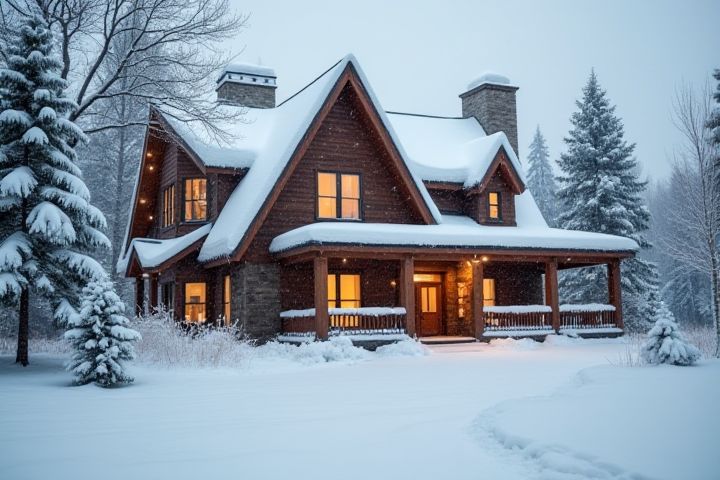
Renovating a house during winter can present unique challenges, but it's entirely feasible with proper planning. Cold temperatures can affect materials like paint and adhesives, making it crucial to choose winter-friendly products. Ensure that your heating system is operational to maintain a comfortable working environment, as it helps in effective drying and curing of materials. Additionally, addressing insulation and drafts during renovations will improve energy efficiency and comfort levels in the home. You may want to focus on interior projects that don't rely on good weather, allowing you to maximize your renovation efforts regardless of the season.
Can You Renovate A House During Winter
Weather conditions impact work schedule
Renovating a house during winter can be challenging due to cold temperatures, snow, and ice, which can significantly impact the work schedule. Exterior projects may be delayed as materials can freeze, making installation difficult; for example, concrete needs to be poured at temperatures above 50degF for optimal curing. You may need to allocate extra time for interior work, as heating may be necessary to maintain a suitable environment for tasks like painting or drywall work. Be prepared for potential weather-related stoppages, and factor in an estimated 25% longer timeline for completion during winter months.
Potential for higher contractor availability
Renovating a house during winter offers the advantage of increased contractor availability, as many builders experience a slowdown during colder months, potentially leading to more competitive pricing and flexible scheduling. With contractors often looking for projects to fill their calendars, you may find a wider selection of skilled professionals eager to take on your renovation. Additionally, winter renovation can help you avoid the busy peak seasons, ensuring your project is completed efficiently and on time. Keep in mind that while you benefit from these opportunities, proper planning for heating and insulation is essential to maintain a comfortable working environment.
Heating costs for construction areas
Renovating a house during winter can lead to increased heating costs, especially in construction areas where exposed elements may cause heat loss. To manage these costs effectively, consider using temporary heating solutions like space heaters and insulated enclosures to maintain optimal working temperatures. You can also implement energy-efficient practices, such as sealing gaps and using insulated materials, to minimize heat escape. Investing in a well-planned heating strategy not only enhances comfort for your construction crew but also helps control your overall renovation budget.
Moisture-related issues
Renovating a house during winter poses unique challenges, particularly related to moisture-related issues. Cold temperatures can lead to increased humidity levels in unheated spaces, fostering mold and mildew growth, which affects air quality and structural integrity. To mitigate moisture problems, ensure proper ventilation and consider using dehumidifiers to maintain optimal humidity levels below 60%. Furthermore, insulating pipes and sealing drafts not only enhance energy efficiency but also protect against freezing and moisture accumulation within your home.
Limited daylight hours
Renovating a house during winter presents unique challenges, particularly due to limited daylight hours that can affect project timelines and efficiency. Ensuring adequate artificial lighting is essential; utilizing LED work lights can improve visibility in dimly lit spaces and enhance safety. Employing insulated and energy-efficient materials can help maintain comfort levels, while also speeding up the renovation process by providing a stable environment for work. Planning your tasks around daylight availability, such as conducting exterior work during peak hours, allows you to maximize productivity despite the shorter days.
Need for temporary coverings
Renovating a house during winter often necessitates the use of temporary coverings to protect construction areas from harsh weather elements. These coverings can include tarps, plastic sheeting, or heated enclosures that maintain a stable temperature for essential work, such as drywall installation or painting. Proper installation of these protective barriers not only ensures adequate protection from snow and rain but also helps to prevent moisture-related issues like mold growth. By implementing effective temporary coverings, you can mitigate winter's challenges while successfully progressing with your home renovation project.
Impact on exterior projects
Renovating a house during winter poses unique challenges, especially for exterior projects. Cold temperatures, typically below 32degF (0degC), can impede paint drying times, affect concrete pouring, and harm exterior finishes. Snow and ice accumulation also complicate access to job sites, leading to potential delays in timelines and increased labor costs. Taking these factors into consideration is crucial for maintaining project quality and avoiding costly setbacks while enhancing your home's exterior.
Potential for material delays
Renovating a house during winter can be challenging due to the increased potential for material delays. Cold temperatures often necessitate the use of heat or weather protection for specific materials, particularly paints and adhesives, which can extend drying times. Additionally, supply chain disruptions are common in winter months, as adverse weather can impede transportation, leading to delayed deliveries of essential supplies by an average of 10 to 20 days. To mitigate these risks, planning your renovation timeline with buffer periods for material arrival is crucial for project success.
Indoor-focused renovations ideal
Renovating a house during winter can be an excellent opportunity to focus on indoor projects that enhance comfort and aesthetics. Consider upgrading your home's insulation, which can significantly improve energy efficiency and reduce heating costs. Indoor painting or wallpapering can refresh your living spaces without the distraction of outdoor weather conditions. You might also invest in new flooring options, such as hardwood or luxury vinyl, ensuring your home remains cozy while elevating its overall design.
Potential for cost savings
Renovating a house during winter can lead to significant cost savings, as contractors often have lower demand and may offer discounts. Labor costs can decrease by approximately 10-20% during the off-peak season due to reduced competition. Additionally, certain materials, such as insulation, are more effective when installed in cooler temperatures, ensuring better long-term energy efficiency. Investing in winter renovations can ultimately enhance your home's value while taking advantage of favorable pricing opportunities.
